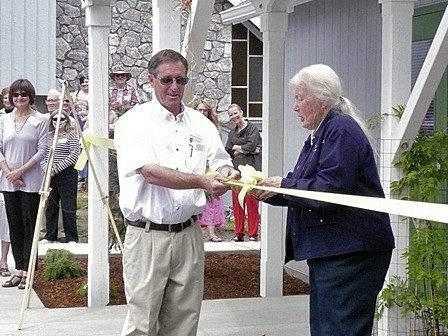by MADIE MURRAY
Special to the Sounder
It’s a few minutes to five on a chilly Thursday evening when volunteers start arriving at the Orcas Food Bank building on Madrona Street to hand out free groceries to individuals who will be stopping by. About 10 are already in front chatting and commiserating, waiting for the door to open. Earlier in the day, apples, potatoes, loaves of fresh bread, even cans of dog food have been left at the large donation box just outside the side door of the building. These and a myriad of other items wait on the shelves to go home to a grateful family.
“There are many reasons people come to the food bank,” says 12-year food bank volunteer Sharon Bearchell. “For most it’s circumstance: a lost job, disabilities limiting their ability to work or a rough time in their otherwise productive life.”
By Christmas, it’s anticipated that up to 300 people representing about 90 families will be coming to the food bank every week to receive free groceries.
The food bank has various ways it keeps its shelves stocked besides local residents bringing items directly to its donation boxes at any time day or night. Local farmers and home gardeners have a “Plant A Row” program in the summer. Jeff Rodenberger makes trips to the Bellingham Food Bank once a month on his own nickel to pick up hundreds of pounds of government subsidy items and other foods from Northwest Harvest.
“It’s just something I like to do,” he says.
The food bank receives fresh salmon already filleted from Glenwood Springs hatchery when the runs are good, and apples, pears, plums and berries are dropped off by residents whose trees and bushes bear more than they can possibly eat alone. And, of course, cold, hard cash keeps the wheels turning. Virtually all funding comes from private donations and grants.
“We’re always in need of cash for food purchases not covered by government subsidies. That constitutes about 90 percent of our expenses; and, of course, there’s also the obvious bills such as electricity, phone and general operations needs,” says Larry Shaw, Food Bank Board President.
Food banks across the nation were doing exactly the same. But for our island, the Orcas Food Bank has a special heart and soul just for its own who stop by once a week on either Thursday between 5:30 and 6:30 p.m. or Tuesday between 12:30 and 2 p.m.
Fall and winter are high-demand months and the fall food and funding drive is in full swing. Cash donations may be sent to PO Box 424, Eastsound, WA 98245. For information, visit www.orcasislandfoodbank.org or call 376-4445.



